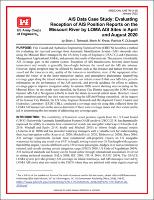Please use this identifier to cite or link to this item:
https://hdl.handle.net/11681/42980Full metadata record
| DC Field | Value | Language |
|---|---|---|
| dc.contributor.author | Tetreault, Brian J. | - |
| dc.contributor.author | Kress, Marin M. | - |
| dc.contributor.author | DiJoseph, Patricia K. | - |
| dc.date.accessioned | 2022-01-21T13:55:39Z | - |
| dc.date.available | 2022-01-21T13:55:39Z | - |
| dc.date.issued | 2022-01 | - |
| dc.identifier.govdoc | ERDC/CHL CHETN-IX-58 | - |
| dc.identifier.uri | https://hdl.handle.net/11681/42980 | - |
| dc.identifier.uri | http://dx.doi.org/10.21079/11681/42980 | - |
| dc.description | Technical Note | en_US |
| dc.description.abstract | This Coastal and Hydraulics Engineering Technical Note (CHETN) describes a method for evaluating the received coverage from Automatic Identification System (AIS) shoreside sites along the Missouri River managed by the US Army Corps of Engineers (USACE) Lock Operations Management Application (LOMA), and presents the results of that analysis. The purpose is to identify AIS coverage gaps in the current system. Reception of AIS transmissions between shore-based transceivers and vessels is generally line-of-sight between the vessel and the AIS site antenna. However, signal reception may be affected by factors such as the distance and terrain between the vessel and the transceiver site, quality of the transceiver installation, state of the equipment either aboard the vessel or at the shore transceiver station, and atmospheric phenomena. Quantifying coverage gaps along the inland waterways system can inform research that uses AIS data, provide information on the performance of the AIS network, and provide guidance for efforts to address coverage gaps to improve navigation safety. In autumn 2020, severe shoaling was occurring on the Missouri River. As the shoals were identified, the Kansas City District requested the LOMA system transmit AIS Aid to Navigation (AtoN) to mark the shoals in several critical areas. However, vessel pilots sometimes reported that they were not receiving the AIS AtoN being transmitted. At the request of the Kansas City District, the US Army Engineer Research and Development Center, Coastal and Hydraulics Laboratory (ERDC-CHL), conducted a coverage analysis using data collected from the LOMA AIS transceivers in the area to determine if there were coverage issues and their extent and to aid in determining the best means of addressing any coverage gaps. | en_US |
| dc.description.sponsorship | Navigation Systems Research Program (U.S.) | en_US |
| dc.format.extent | 11 pages / 5.69 MB | - |
| dc.format.medium | - | |
| dc.language.iso | en_US | en_US |
| dc.publisher | Coastal and Hydraulics Laboratory (U.S.) | en_US |
| dc.publisher | Engineer Research and Development Center (U.S.) | - |
| dc.relation.ispartofseries | Technical Note (Engineer Research and Development Center (U.S.)) ; no. ERDC/CHL CHETN-IX-58 | - |
| dc.rights | Approved for Public Release; Distribution is Unlimited | - |
| dc.source | This Digital Resource was created in Microsoft Word and Adobe Acrobat | - |
| dc.subject | Navigation--Performance | en_US |
| dc.subject | Inland navigation | en_US |
| dc.subject | Ships--Automatic identification systems | en_US |
| dc.subject | Missouri River | en_US |
| dc.title | AIS data case study : evaluating reception of AIS position reports on the Missouri River by LOMA AIS sites in April and August 2020 | en_US |
| dc.type | Report | en_US |
| Appears in Collections: | Technical Note | |
Files in This Item:
| File | Description | Size | Format | |
|---|---|---|---|---|
| ERDC-CHL CHETN-IX-58.pdf | 5.69 MB | Adobe PDF |  View/Open |